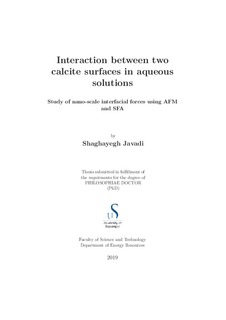| dc.contributor.advisor | Røyne, Anja | |
| dc.contributor.author | Javadi, Shaghayegh | |
| dc.date.accessioned | 2019-12-05T10:32:02Z | |
| dc.date.available | 2019-12-05T10:32:02Z | |
| dc.date.issued | 2019-11 | |
| dc.identifier.issn | 1890-1387 | |
| dc.identifier.uri | http://hdl.handle.net/11250/2631925 | |
| dc.description.abstract | Carbonate-bearing rocks in the upper Earth’s crust are prone to continuous changes under influences of various physical and chemical processes. The macroscopic mechanical strength of carbonates is generally controlled by the cohesion between contacting grains at a molecular scale. These grains deform in contact regions due to the chemistry of pore fluid. The repulsive and attractive forces that perate at the grain contacts may be affected by the dissolution and recrystallization kinetics at the mineral-liquid interfaces. The processes by which the nano-scale interfacial forces are influenced by changing properties of the confined fluid are largely unknown. In this thesis, I investigate these processes and their possible contribution to the strength of calcite-bearing rocks and materials.
The Atomic Force Microscope (AFM) and Surface Force Apparatus (SFA) are two powerful tools that provide an opportunity of direct observation of mineral reactions to the contacting fluid and measuring the surface forces at nano-scale in air and liquid environments. In this project, we perform an extended number of experiments using the AFM and SFA to improve our understanding of variation in interfacial forces linked to the strength of calcite and calcite-bearing rocks.
In the AFM experiments, we bring an in situ fabricated calcite probe into contact with an opposing freshly cleaved calcite surface in a fluid cell containing aqueous solutions with varying chemical compositions. We also combine the AFM force measurements with a technique called inverse imaging, for in situ simultaneous characterization of the calcite probes. Based on these experiments, we discuss that the possible variation in local topography of contacts, together with a strong dependence on ionic strength of the solution, can explain the variation in strength of calcite rocks in aqueous solutions.
With the SFA, we can perform in situ observations of the possible changes in the surfaces via light interferometry technique while measuring the interfacial interactions at nano-scale. At this scale, interactions between contacting surface asperities define the nature of interfacial forces, repulsive or attractive. We discuss how the crystal growth, dissolution and changes in surface roughness affect these interaction forces and their implications on the strength of calcite-bearing rocks. | nb_NO |
| dc.language.iso | eng | nb_NO |
| dc.publisher | Stavanger: University of Stavanger | nb_NO |
| dc.relation.haspart | Paper 1: Javadi, S,. Røyne, A. (2018) Adhesive forces between two cleaved calcite surfaces in NaCl solutions: The importance of ionic strength and normal loading. Journal of Colloid and Interface Science, 532, pp. 605-613 | nb_NO |
| dc.relation.haspart | Paper 2: Dziadkowiec, J., Javadi, S., Bratvold, J.E., (2018) Surface Forces Apparatus Measurements of Interactions between Rough and Reactive Calcite Surfaces. Langmuir, 34(25), pp 7248-7263 | nb_NO |
| dc.relation.haspart | Paper 3: Javadi, S., Røyne, A. (2019) Direct observation of AFM calcite probe: Implication for calcite roughness evolution measurement. In preparation/not in print | nb_NO |
| dc.rights | Navngivelse 4.0 Internasjonal | * |
| dc.rights.uri | http://creativecommons.org/licenses/by/4.0/deed.no | * |
| dc.title | Interaction between two calcite surfaces in aqueous solutions: Study of nano-scale interfacial forces using AFM and SFA | nb_NO |
| dc.type | Doctoral thesis | nb_NO |
| dc.subject.nsi | VDP::Mathematics and natural science: 400::Geosciences: 450 | nb_NO |

